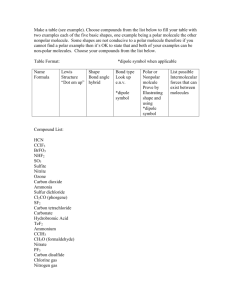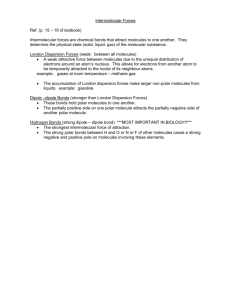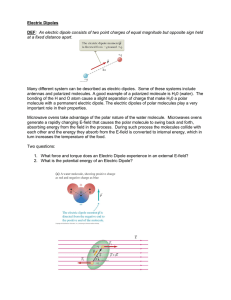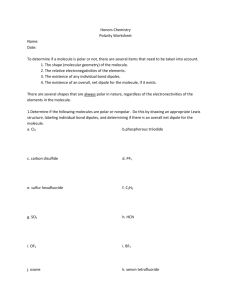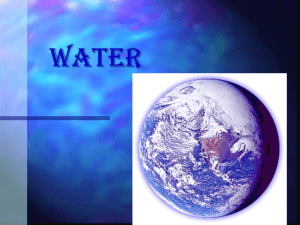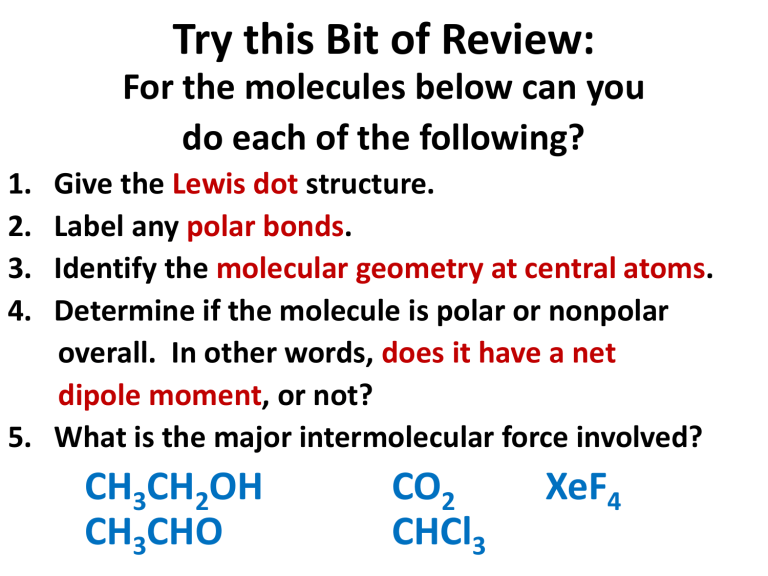
Try this Bit of Review:
For the molecules below can you
do each of the following?
1.
2.
3.
4.
Give the Lewis dot structure.
Label any polar bonds.
Identify the molecular geometry at central atoms.
Determine if the molecule is polar or nonpolar
overall. In other words, does it have a net
dipole moment, or not?
5. What is the major intermolecular force involved?
CH3CH2OH
CH3CHO
CO2
CHCl3
XeF4
Recall that some covalent bonds have as much as 1000 kJ/mol in bond energy!
WELCOME to University Chemistry 2!
Yes, it’s true that you
are ultimately
responsible for your
own learning.
However……
I take very seriously my
responsibility to help
you reach your goals,
learn all you can, and
to have your efforts
evaluated fairly.
I don’t feel successful
unless you do!
We are in this together!
What I learned about how to
succeed in chemistry:
1. Do ALL the homework; practice until you
understand it.
2. Develop better study habits.
3. Wake up! Don’t sleep through class and
pay attention in lecture.
4. Take excellent notes and review them
daily.
5. Talk with the professor; ask for help.
6. Practice the goals A LOT!
7. Do NOT procrastinate. Study every
night.
What I learned about how to
succeed in chemistry:
8. Do not get behind; learn good timemanagement.
9. Be organized; practice constantly.
10. Go to your SI group and be prepared.
11. Work with others; form a study group.
12. Use the study guides and practice exam
questions; rework the LC ones, too.
13. Study for tests early. Do NOT cram!
14. Use the CLASS+; get tutoring if needed.
15. Remember the 3 hour rule; keep up and
review constantly.
Let’s try out our
in-class platform!
•
Log in to “Learning Catalytics” by going to the
Learning Catalytics website directly:
https://learningcatalytics.com/sign_in
• Enter today’s Session ID (on the board).
• Choose your seat on the seating chart.
• If you have problems raise your hand and help
will come to you, thanks to our TAs and SI
Leaders!
More on homework!
• See blackboard for full instructions and info!
• Homework is due this semester by 11:59 pm on due dates
shown in the program.
• Dr. Moradi is your faculty person in charge of that
portion of our course if you have questions.
• There are computer labs and tech support available, but you
will want to work ahead on these to avoid the frustration of
last minute technical issues.
• First assignment is due this coming Sunday.
• LB’s suggestion: Take a look at the conceptual and
terminology questions in your text as you read before class.
The lecture will be more meaningful and LC questions easier
if you prepare well for class. Then do the harder problemsolving ones in the textbook after we’ve worked on that
learning objective in class. The MC work will be easier and
quicker if you do the book work and review your lecture notes
before getting into the problems in MC.
CHEMISTRY 1123
DATE
WEEK 1 (Week of January 14):
University Chemistry II
SPRING, 2019
LEARNING OBJECTIVES:
ASSIGNMENT:
1. Introductions and expectations:
What can I expect from this course and what is expected
of me?
Take the Learning Styles Inventory and bring your results to
the SI group discussion next week. Go to the site:
http://www.engr.ncsu.edu/learningstyles/ilsweb.html
Be sure to register for your SI
2. Review your understanding of the solid, liquid and gas phases
group through CLASS+ site.
at the molecular level.
Chapter 11.2
http://class.uark.edu
3. Review polar bonds and polar molecules.
Chapter 5.2, 5.10
4. Review the interactions involving polar molecules and nonpolar
Chapter 11.3; Learn Table 11.4
Start your Mastering Chemistry
on-line homework!
molecules as well. Practice identifying intermolecular forces.
Complete your ALEKS pre-course
work.
5. Review the importance of intermolecular forces in
Chapter 11.3
properties such as solubility, boiling points, etc.
6. Review applications of the strengths of intermolecular forces to
Chapter 11.4
properties like surface tension, viscosity, capillary action, etc.
7. Learn about the process and energetics of vaporization.
Chapter 11.5
8. Learn about vapor pressure and the dynamic equilibrium
Chapter 11.5
between liquid and gas phases
WEEK 2 (Week of January 21)
9. Use the DHv ap and the Clausius-Clapeyron equation to
LABS and SI Groups BEGIN!
predict changes in vapor pressure with changes in temperature.
Chapter 11.5
Martin Luther King, Jr. Celebration
January 21 so no class on Monday! 10. Learn about the transitions that occur at the critical point,
and during sublimation, fusion, melting, and freezing.
Chapter 11.5, 11.6
Learning Objective #2:
Comparing the solid, liquid, and gas
phases (states) at the molecular level
• The state of a sample of matter depends
on the strength of the ______________
forces between the particles relative
to the amount of thermal energy
in the sample.
• Molecules and atoms are in constant
random motion that __creases with
increasing temperature. As temperature
increases, a change of state may occur.
What observations can you make about water in its 3 states?
Fig. 11.1
Fig.11.2
Are there other states of matter?
The three we experience daily and study in this course:
• Solid
• Liquid
• Gas
But there are others:
• Plasma
• Bose-Einstein Condensate (Nobel Prize in Physics
2001)
http://www.nasa.gov/mission_pages/solar-b/solar_017.html
http://patapsco.nist.gov/imagegallery/details.cfm?imageid=193
Figure 11.3
Changes Between States
We can transition between states by changing
temperature, pressure, or both.
endothermic
e
exothermic
LO 2
What is going on here?
The propane in an LP gas tank is
in the liquid state. When you open
the tank, some propane vaporizes
and escapes as gas.
Propane is a gas at room temp and
atmospheric pressure. Under high
pressure (>2.7 atm) it liquefies.
In general if you increase pressure,
the __________ state is favored.
If the diagram to the left
represents liquid water,
which one below
represents what happens
to the water when a pot of
water boils?
Liquid to gaseous water
Figure 11.20
Figure 11.26
Figure 11.33
LEARNING OBJECTIVE #3:
Another Review Goal!
1. Can you draw Lewis dot structures?
2. Can you find polar bonds?
3. Can you determine molecular
geometry?
4. Can you determine if the molecule
has a net dipole?
REVIEW Chapter 5 material as needed!
Now let’s learn to predict polarity in bonds.
We will use the electronegativity values given in
Figure 5.3. Look for the trends in EN here, too!
So, what is electronegativity?
• It’s the ability of an atom in a molecule to attract
shared electrons to itself….it’s the “greediness”
factor!
• If the difference in EN is > 0.4 we’ll consider the
bond polarized.
• The polarity of the bond increases as the
difference in EN values increases.
Do NOT memorize,
but know trends and
the most EN top four!
Figure 5.3
• On the periodic table, electronegativity
generally ___creases across a period (row)
and ___creases up a group (column).
• The range of electronegativity values is from
4.0 for fluorine (the most electronegative) to
0.7 for cesium and francium (the least
electronegative).
_______________developed
a scale for us to use.
B.S. in chemical engineering
Ph.D. in chemistry
Copyright © Cengage Learning.
All rights reserved
Nobel Prizes:
1954 (__________)
27
1963 (_________)
Electrostatic Diagram Showing
Three Possible Types of Bonds
__Pure__ covalent
__Polar___covalent
DEN = 1.9
___Ionic______
DEN > 1.9
So, why are some molecules with polar bonds
behaving as if they are not polar?
For Example: CCl4, CO2, XeF4?
1. Label all “dipoles” or polar bonds.
2. Now consider the geometry (shape) of the
molecule. Why?
3. In a symmetrical arrangement, identical
dipoles can actually cancel each other out
giving the molecule a net dipole moment
of ___zero_____.
4. When the dipoles cancel, the molecule
behaves as if it is ___nonpolar______!
How does this new knowledge of molecular
geometry apply to polarity issues?
Ask:
1. Does my molecule have any polar bonds?
2. If it does, how are they arranged?
3. If the polar bonds are equal in magnitude, AND
symmetrically arranged in the opposite directions,
the dipoles can cancel each other and result in a
molecule that is “nonpolar”overall (with no net
dipole).
4. Geometries with no lone pairs on the central atom
are symmetrical. Most with lone pairs are not.
5. Geometries with 2 bonds and 3 lone pairs (________)
or 4 bonds with 2 lone pairs (_____________) are
also symmetrical.
Molecular Shape and Polarity
If a molecule has one polar bond, the molecule
will be ____________.
For example: HF, HCl, CH3F
If a molecule has two or more identical polar
bonds, it may or may not be polar,
depending on the _____________.
Why is water so different?
The lone pairs give a _____ geometry and dipoles
do not cancel, but are additive here instead.
Three identical bonds in trigonal
planar geometry will cancel, so
_________dipole.
Four identical bonds in a
tetrahedral geometry as
with CCl4 will cancel, so
____________dipole.
What about CH3Cl?
Notice the lone pair, the
trigonal pyramidal
geometry and the net
dipole that results.
In both of these, there is
a symmetrical geometry with
identical dipoles, so _________dipole.
Which of these
has no net dipole?
Can you name their
molecular geometries, too?
What is going on here? Will the dipoles cancel?
In which of these
will the dipoles
cancel giving
no net dipole?
Practice:
Label each of the following by molecular
geometry and as polar covalent or
nonpolar covalent (with no net dipole).
A.
B.
C.
D.
E.
F.
G.
H.
PCl3
SiCl4
BCl3
ICl3
AsF5
ClF5
XeF4
Cl2CO
Practice:
Label each of the following by molecular
geometry and as polar covalent or
nonpolar covalent (with no net dipole).
A.
B.
C.
D.
E.
F.
G.
H.
PCl3 trigonal pyramidal
SiCl4 tetrahedral
BCl3 trigonal planar
ICl3 T-shaped
AsF5 trigonal bipyramidal
ClF5 square pyramidal
XeF4 square planar
Cl2CO trigonal planar
polar
nonpolar
nonpolar
polar
nonpolar
polar
nonpolar
polar
TABLE 5.5
First a comparison:
Intramolecular Bonding
• Bonds that form “_________” the molecule.
• Molecules are formed by sharing electrons between
the atoms.
Intermolecular Forces
• Forces that occur ________________ molecules.
Dipole–dipole forces
Hydrogen bonding
London dispersion forces
NOTE: Intramolecular bonds are stronger than
intermolecular forces.
Types of Intermolecular (Attractive) Forces
• Temporary polarity in the molecules due to unequal
electron distribution leads to attractions called
dispersion forces (sometimes called London dispersion
forces).
• Permanent polarity in the molecules due to their
structure leads to attractive forces called dipole–
dipole attractions.
You can predict net dipole now, right?
• An especially strong dipole–dipole attraction results
when H is attached to an extremely electronegative
atom like a ___________. These are called hydrogen
bonds (H-bonding).
Recall that some covalent bonds have as much as 1000 kJ/mol in bond energy!
A summary of IMFs and their strength.
1. Typically London dispersion forces are the
weakest of the IMFs and are most significant
in nonpolar molecules.
a) _________ molecules or atoms have greater strength
b) more surface area ___creases strength
2. Polar molecules have net dipoles, and
the stronger the dipole, the stronger
the dipole-dipole IMFs.
3. Hydrogen bonding is an extra strong
dipole-dipole force.
Some more practice on today’s work:
1. Which of the following would have only London
dispersion forces as the IMFs?
1. ICl3
2. AsF5
4. XeF4
5. Cl2CO
3. ClF5
2. Give the major intermolecular force at work in
each of the following:
a) CH3OCH3
c) CH3CH2CH3
e) H2CO
b) CH3CH2NH2
d) CF4
London Dispersion Forces
• Instantaneous dipoles that occur spontaneously and
fleetingly in a given atom and then induce similar dipoles
in neighboring atoms
• Significant in large atoms/molecules
• Larger surface area facilitates the formation of these
induced dipoles.
• Occurs in all molecules, including ____________ ones
Figure 11.4
Why the
increase
in boiling
point with
increase
in molar
mass?
Another example of how size impacts
dispersion forces (Fig. 11.6):
Why the difference
in boiling points?
The molar mass
is the same for
these “isomers”.
Figure 11.5
Dipole-Dipole Forces
• Dipole moment – molecules with polar bonds
often behave in an electric field as if they had a
center of positive charge and a center of negative
charge (a _____ _________, right?).
• Molecules with dipole moments can attract each
other electrostatically. They line up so that the
positive and negative ends are close to each
other.
• Only about 1% as strong as covalent or ionic
bonds.
Polar molecules have a _____________dipole.
• Bond polarity and molecular geometry
(shape) determine the substances polarity
• If the molecule has a dipole moment, then
it will interact with another polar molecule.
NOTE: A permanent dipole adds to the attractive
forces between the molecules, _____________
the boiling and melting points relative to
nonpolar molecules of similar size and shape.
Shows how a nonpolar and a polar molecule of comparable size compare!
Fig. 11.7
Hydrogen Bonding
in Water
The blue dotted lines
are the intermolecular
forces between the
water molecules called
“hydrogen bonds”.
Hydrogen bonds are very
strong dipole-dipole forces
Hydrogen is bound to a highly
__________________ atom.
Look for hydrogen bound to
________________________.
Fig. 11.11
Shows the difference hydrogen bonding makes.
Which of the following would have the highest boiling point?
Explain your choice to your neighbor.
Figure 11.13
The Boiling Points of the Covalent Hydrides of
the Elements in Groups 4A, 5A, 6A, and 7A
In general,
the boiling
and the
melting
points
____crease
with the
strength of
intermolecular
forces in the
substance.
Copyright © Cengage Learning.
All rights reserved
61
Which of the following compounds is likely to
have an unexpectedly high boiling point?
And, there is one more to consider!
Figure 11.14
Recall that some covalent bonds have as much as 1000 kJ/mol in bond energy!
Attractive Forces and Solubility
• Solubility depends, in part, on the attractive forces of the solute and
solvent molecules.
– Like dissolves ______.
– Miscible liquids will always dissolve in each other.
• Polar substances dissolve in ________ solvents.
• Nonpolar molecules dissolve in ________ solvents.
• Many molecules have both hydrophilic (________) and hydrophobic
(_______________) parts.
– Solubility in water becomes a competition between the attraction
of the polar groups for the water and the attraction of the
nonpolar groups for another nonpolar group.
Pentane is a ________ liquid
and water is a _______ one,
so they are immiscible.
Gasoline
Floating on
Water
E.R. Degginger/Color-Pic, Inc.
Would you think
hexane or methanol
would be a better
solvent for grease?
Vitamin A and Vitamin C
Which is a “fat soluble” and which is a
“water soluble” vitamin?
(hydrophobic vs. hydrophilic)
And what do polar bears
have to do with it???
Frank Cox
Nonpolar region
polar
Fat-soluble or water soluble vitamin?

